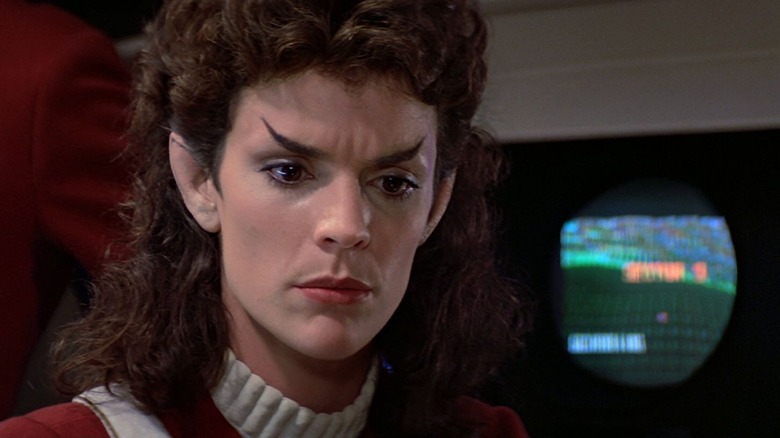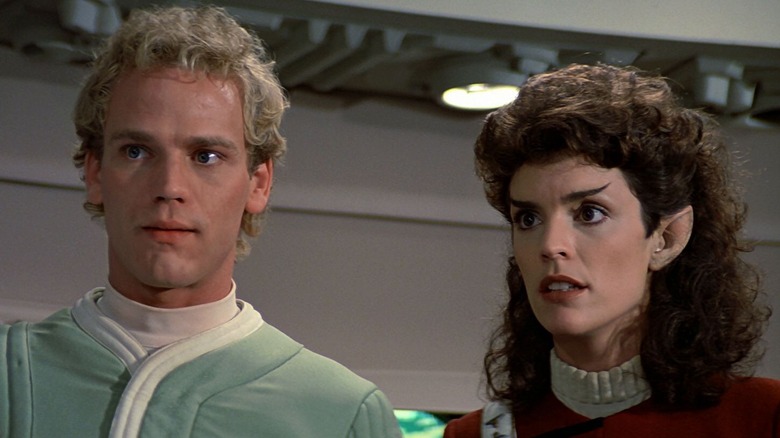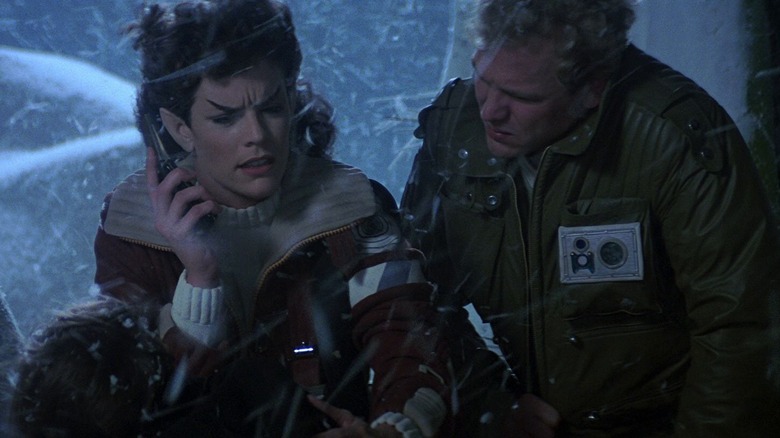Star Trek's Robin Curtis Blames Leonard Nimoy For A Common Saavik Complaint
In Leonard Nimoy's 1984 film "Star Trek III: The Search for Spock," the Vulcan officer Saavik (Robin Curtis) was tasked with exploring and mapping the Genesis planet, a brand-new world that had been instantaneously formed by the Genesis Device, a terraforming widget introduced in the previous movie. The Genesis planet, she found, was evolving at too rapid a pace, rotating through seasons at an hourly rate. It was hot and muggy one hour, then snowy the next. By the end of the movie, the Genesis world will prove to be unstable, crumbling from within. It was too good to be true.
The deterioration is only one of several tragedies that occur throughout the film. During a rescue operation, Admiral Kirk (William Shatner) has to destroy the U.S.S. Enterprise, and his son David (Merritt Butrick) is murdered by Klingons. Saavik, being an emotionless Vulcan, witnesses these tragedies with a stone face. She tries instead to view them with detached intellect. Robin Curtis gave a mature and stony performance, wholly appropriate for the character.
But this was a change for Saavik, as in the previous film — when the character was played by Kirstie Alley — she was far more emotional. She was confused by humans and even shed tears at the funeral of Spock (Nimoy). Somehow, Saavik became a lot less emotional from "Star Trek II: The Wrath of Khan" to "Star Trek III," a change that many Trekkies have noticed and complained about.
Curtis, of course, has been asked about the character changes she made to Saavik in "Star Trek III," and she has a simple answer. It seems that Nimoy merely directed her that way. Nicholas Meyer directed "Star Trek II," and Kirstie Alley had a different approach to the character. Curtis, in contrast, trusted that Leonard Nimoy, essentially a co-creator of Vulcans, would tell her the best way to behave. Curtis talked about Saavik recently on the SciFi Diner Podcast.
Put your trust in Leonard Nimoy
Curtis was still in the early years of her career when she made "Star Trek III," so she had to approach Nimoy during production and admit up front that she didn't know anything about Vulcans; Curtis was no Trekkie. Nimoy, luckily, put her mind at ease and directed her very closely. When asked about Saavik's change, Curtis credited Nimoy, saying:
"I admit it was very much direction. But it was my preference to be that actor who just put herself in the hands of the King Vulcan. Who was I to go into the franchise and go, 'Well, you know, this is what I think a Vulcan woman would do and say.' I shook Mr. Nimoy's hand the first day of work, and said, 'You seem to think I know what I'm doing, but I really don't.' And he said, 'Robin, I'll take you every step of the way.'"
So Curtis wasn't really concerned about the grand arc of her character from one film to the next. She made herself familiar with Saavik, of course, but had the difficult job of reprising the role of another actress while still making the part her own. She also felt that the creation of a new Saavik was a collaboration. Indeed, the creation of any character is an amalgam of insights offered by the writer, the director, and the actor. Curtis saw her craft as one of cooperation.
The collaboration between actor and director
Of course, Trekkies don't look at characters quite the same way. Trekkies are sticklers for continuity and love to link distant pieces of the franchise back to the present, looking for references and — just for fun, mind you — continuity errors. As such, Trekkies will often ask Curtis about in-universe reasons as to why Saavik went from looking like Alley to looking like Curtis. The actress, of course, has had to rein in a few enthused fans, reminding them that she is just an actress working a job. But, of course, never in a condescending way. Curtis noted:
"When people comment on the subtle differences or perhaps some of the more obvious differences between the two portrayals, I have to remind them I think it's very much a collaboration between the artist and the director, for sure. Obviously, Nicholas Meyer and Kirstie kind of went to the edges of the emotion and the flirtation, and they brought some nuances to the character that Leonard Nimoy would have no part of. He didn't want me to breathe in the wrong place, as much as I tried to inject that little layer of emotion. It wasn't happening. He wasn't having it."
Personally, I prefer Nimoy's approach. Vulcans are more interesting to me when they retain their composure, not when they "break" and show their emotions. Spock has always been a better character the less human he was, serving as a logical counterpoint to the passions of Captain Kirk or Dr. McCoy (DeForest Kelley). The same principle should be applied to all the Vulcans in "Star Trek." The franchise is already lousy with humans, and an additional emotional point of view isn't necessary. By making Saavik colder and less emotional, Nimoy improved the character.
And Curtis, of course, handled his direction with aplomb.


